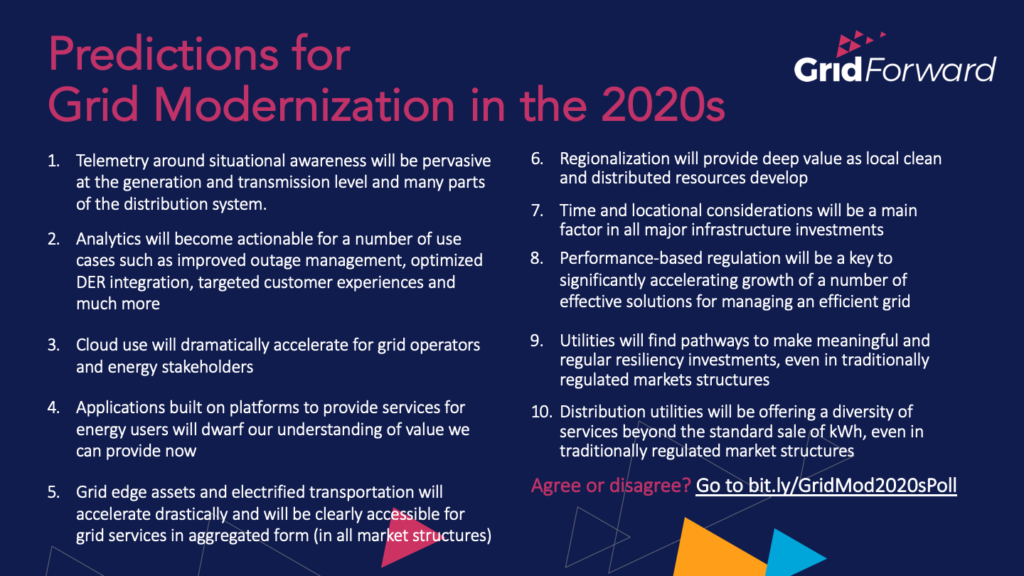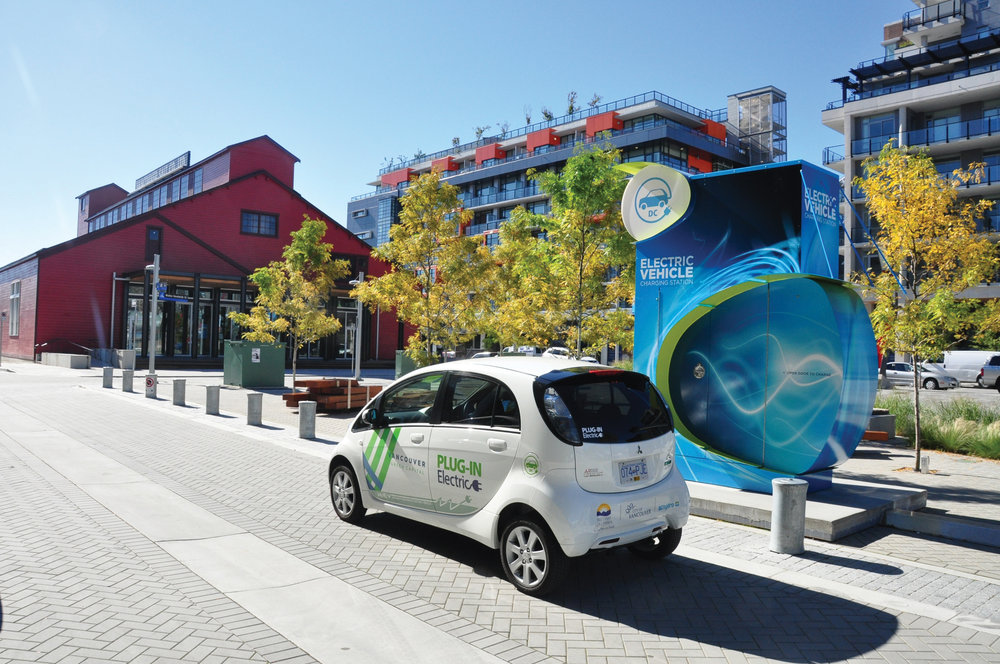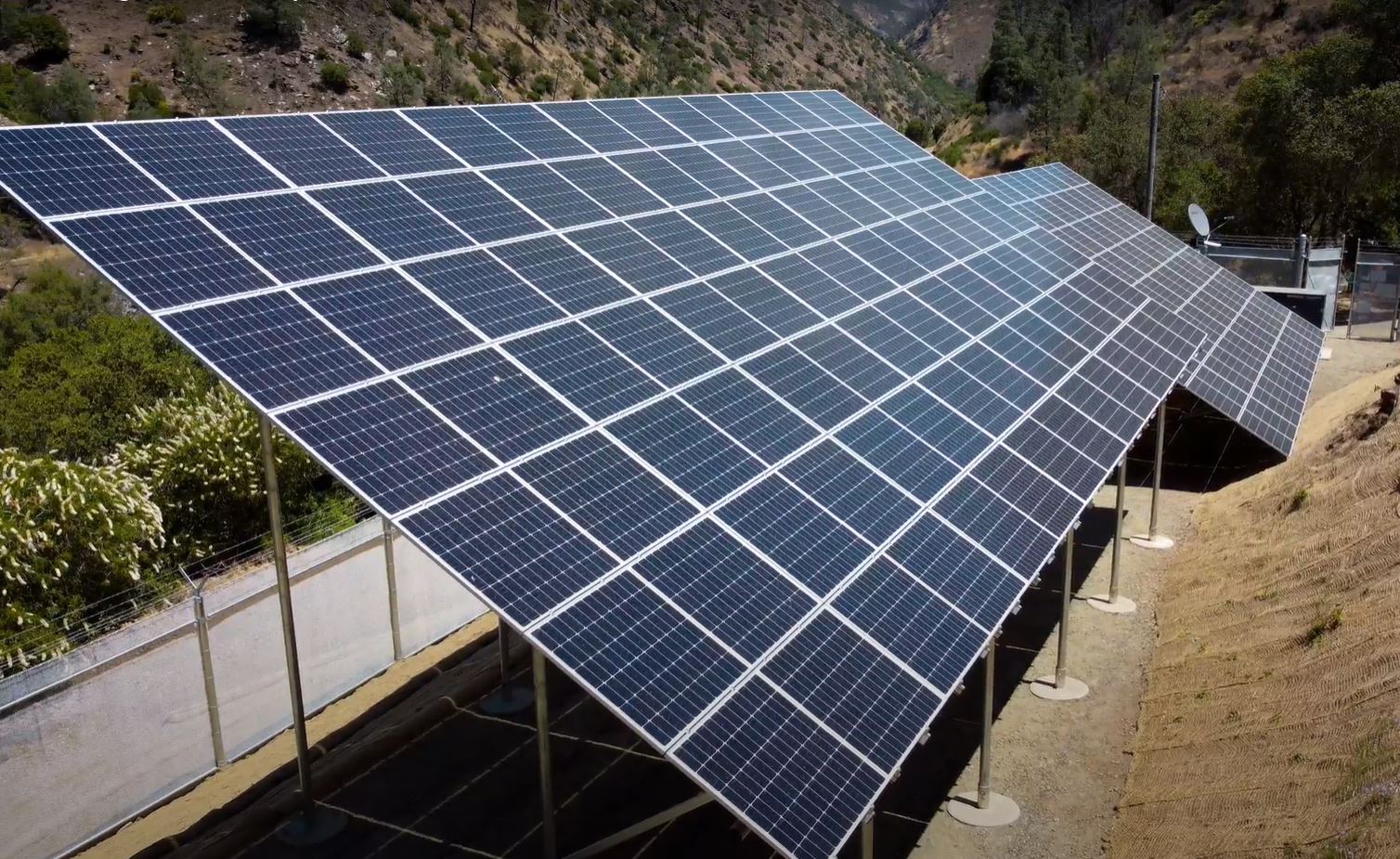The Grid Forward organization was formerly launched in June of 2019, but our roots go back to 2010, when a group of forward-looking energy experts banded around the name “Smart Grid Oregon.” Now we look forward to our first full year as Grid Forward, and the huge potential of grid modernization in the coming decade. We asked some of our influential friends to help us imagine what the next 10 years will bring to our industry and our region.
You can meet our group of influencers in the first article in this two-part series, GridMod2020 Part 1: How Far Has the Smart Grid Come Since 2010? The group reflects the range of stakeholders that are helping Grid Forward accelerate grid innovation: utilities, regulators, consultants, tech providers, and investors.
- Jeff Ackermann, Chairman, Colorado PUC
- Larry Bekkedahl, VP Grid Architecture, Integration & Systems Operations, Portland General Electric
- Patricia Bourne, CEO, EQUS
- Cassie Bowe, Vice President, Energy Impact Partners
- Colton Ching, senior vice president of planning and technology, HECO
- Scott Corwin, Exec. Dir., NWPPA
- Marissa Hummon, CTO, Utilidata
- Carl Imhoff manages the Electric Infrastructure market sector at PNNL
- Travis Kavulla, Vice President, Regulatory Affairs, NRG
- Nancy Pfund, Managing Partner, DBL Partners
- Jenny Potter, Commissioner, Hawaii PUC
- Mischa Steiner, CEO, Awesense
In the first part, they commented on 10 grid technology predictions made by IDC way back in 2010. In this article, Grid Forward proposes some grid modernization trends (below) that build on the progress of the energy transitions that accelerated in the 2010s. We asked our influencers for their opinions on these advances, and you can see their responses below.
Which ones do you agree (or disagree) with? Are there any other trends you think are important enough to make the “top 10” predictions for the 2020s? Take this short survey and share your opinion–we’ll wrap it all up in an article next month.

1. Telemetry around situational awareness will be pervasive at the generation and transmission level and many parts of the distribution system
Bekkedahl – Telecommunications will be impacted significantly by 5G. New ways to communicate with sensors across the distribution network will be developed and digital twins of the electric system will be created.
Hummon – Is this still an issue in 2020? And yes, I agree that we will extend telemetry throughout the distribution system over the next ten years. A key technology for that is the smart meter.
Potter – I agree with all the predictions from Grid Forward. I notice a theme to the first seven predictions–most are based on some temporal and spatial intelligence that requires software or application. They are all accurate, but highly related to each other.
2. Analytics will become actionable for a number of use cases such as improved outage management, optimized DER integration, targeted customer experiences and much more
Bourne – It is interesting to note that AMI took a backseat [in the past decade] in our overall discussions, mainly because the technology wasn’t quite there. We held back because we did not want to spend our money twice. In the rural areas the challenges for connectivity continued to be an issue. However, in the past couple of years, innovation drove changes that provided a more economical approach to AMI in the rural area. This technology will create efficiencies and will open up doors for further innovation.
Hummon – I’d go further: analytics without action won’t cut it. Automation will dominate in the 2020s.
Pfund – A couple of these predictions that relate to improved analytics, DER optimization, and IT infrastructure get back to my point that investments in software will have a major impact on the grid going forward.
3. Cloud use will dramatically accelerate for grid operators and energy stakeholders
Bekkedahl – Cloud use will be commonplace across the entire utility enterprise. However, I think the industry must adequately prepare itself for a major cybersecurity event that could potentially halt moving critical applications to the cloud.
Pfund – AI software, which is already playing an increased role in energy trading capabilities, is going to have a pronounced influence in particular. It will allow for more renewables and storage to come online. The ability of AI to optimize for cost and efficiency savings will make renewables assets even more attractive.
Bourne – With world-class artificial intelligence (AI) and machine learning (ML) research and education, Alberta is well positioned to develop and export solutions that enable more efficient performance of power systems, bringing economic and environmental benefits to customers, utilities and Albertans in general.
4. Applications built on platforms to provide services for energy users will dwarf our understanding of value we can provide now
Pfund – Imagine that instead of getting switched off by your local utility during a fire season event, your solar panels instead flipped to run your own home, charge your battery and share the extra power with your neighbors. All done seamlessly without having to program or call an 800 number. And again, without you doing anything, software would be running to expand this network and create a regional trading platform, so that rather than grinding to a halt, whole counties and cities would organize into self-assembling grids capable of keeping the proverbial lights on, and more. This is all part of our clean energy future. Sign me up please!
Steiner – Sign me up for that too. And, in the words of Mahatma Ghandi “Be the change you wish to see in the world”, and that’s what we’re doing. One addition at the State and Federal level is the move to a more global grid through HVDC interconnects. This may or may not happen for a myriad of technical and political reasons. But imagine, not only having a local energy market but a global one too, where you wake up in the morning to see how much energy you sold overnight to the other side of the world!
Steiner – Not only do you need a platform, but you need intelligence to make that platform sing. The energy infrastructure today, is relatively dumb. Don’t get me wrong though, the industry has been doing intelligent things for years (think SCADA) but when we’re trying to tackle a massive paradigm shift from centralized (mostly carbon) based generation to decarbonized and decentralized generation, we will need to fundamentally operate the system in new ways that it wasn’t originally designed to do, without replacing all the existing infrastructure. We still need to operate in the realm of physics, and do so reliably. The benefits are many: not just saving our planet, but also reducing dependence on one entity for our energy future, and enhanced resilience. We will operate energy much in the same way as the Internet operates, and just as information has become abundant and accessible today, so too will energy. All that said, the digitization and digitalization has to take place first, and the value chain of data persists (Data > Knowledge > Insight > Action). Those that can stitch that data together, fix the data that we already have, and create intelligence from it will be the ones to enable this future.

5. Grid edge assets and electrified transportation will accelerate drastically and will be clearly accessible for grid services in aggregated form (in all market structures)
Bekkedahl – Customers want an active role in decarbonization, certainly within Portland General Electric’s service area and throughout the west coast in general. Therefore, demand will accelerate rapidly for grid edge assets, transportation electrification and a vast Electric Avenue EV charging infrastructure like PGE’s growing network. This customer demand will also drive new products like resiliency as a service, transportation electrification and customer energy management.
Bowe – I don’t agree with this prediction, because while the proliferation of these assets will accelerate drastically, I believe “clearly accessible for grid services in aggregated form in all market structures” is quite broad and a goal that we will make very good progress toward but not reach completely by 2030.
Steiner – Agree but disagree “in all market structures.” Not all market structures will either support EV’s (policy, regulation, protectionism) or other factors, like a long-standing emphasis on other technologies that lead to suboptimal outcomes for building out the infrastructure needed, such as hydrogen usage in Japan as a clean alternative to electric.
6. Regionalization will provide deep value as local clean and distributed resources develop
Bekkedahl – Regionalization will provide deep value for distributed resources. Regional planning, risk assessment (RA) standards, the extended day-ahead market (EDAM) and the energy-imbalance market (EIM) will be in operation.
Hummon – I think regionalization is the biggest threat to the big IOUs that span multiple states. Solutions are incredibly local, based on resources and customer interests.
7. Time and locational considerations will be a main factor in all major infrastructure investments
Bekkedahl – All major infrastructure investments will heavily weigh and factor in locational value, customer experience and grid optimization.
Steiner – I disagree, think what the incumbents have to lose.
8. Performance-based regulation will be a key to significantly accelerating growth of a number of effective solutions for managing an efficient grid
Bowe – Don’t agree. I read it as performance-based regulation will happen and will therefore be key to accelerating growth. It will happen in some places but 10 years is not a long time in a regulatory sense to see mass or majority adoption. We saw little movement from 2010 to 2020 on performance-based regulation despite realizing it was a goal at the beginning of the century.
Kavilla – Performance-based rate making risks becoming a buzzword without any real meaning. Its conventional meaning was that utilities should be subjected to some kind of price or revenue cap for a longer duration of time than a typical interval between rate cases. Within that time period, their rates would be adjusted not by whatever they happened to spend, but based on economy-wide factors like inflation and productivity. But a lot of what we hear nowadays on “performance-based rate making” is really this: Make investments that gratify your regulator or politician, and get a bonus return! That’s too bad. We should, in the new decade, expect utilities to put on their big-boy [or big-girl!] pants, rather than continue a legacy of being clients of the state.
9. Utilities will find pathways to make meaningful and regular resiliency investments, even in traditionally regulated markets structures
Potter – I would add something about the emergence of microgrids as a resilience strategy for many communities, or for integrating DERs in a location so that they can provide grid services. We will see something come from microgrids in the next decade.
10. Distribution utilities will be offering a diversity of services beyond the standard sale of kWh, even in traditionally regulated market structures
Hummon – Can we go further and say that the dominant, or majority of, revenue will come from services not kWhs?
Steiner – Maybe, if they are smart, they will offer grid services, and leverage the data and field workforce they have. The question is why haven’t they doubled down on this already? Who has the best engineering talent in power? Who has vast amounts of field crews and staff? Who has all the data? The fact that utilities haven’t found a way to build out new business units and ancillary services is disappointing but not all are in this state. Many are working hard to compete in new market structures, that inevitably will affect their business profits in the future.
What About Security and Electrification?
In an industry as large and varied as the electric utility sector, there are so many facets that could play an expanding role in the decade to come. We heard specifically about two other trends from our influencer group:
Ching on cybersecurity– I agree with the top 10 predictions. However, my thought is that the biggest issue – and possibly the greatest challenge we will face in moving forward in grid modernization – is the growing challenge of keeping intelligent and connected components of a modern grid secure. It’s a tough challenge today, and it will become an exponentially more difficult challenge 10 years from now.
Pfund on electrification – As enabling and democratizing technologies – such as solar, batteries, and software – make clean energy cheaper and more reliable, we will see the ‘electrification of everything’. I think we are seeing a lot of innovation in this space. We are at the early stages of entrepreneurs really pushing to bring new electrified products and services to market, often times in sectors we would not think of at first blush.
Let us know your thoughts on predictions for the electrical power industry in the 2020s. Take the survey. Thanks for your thoughts.



